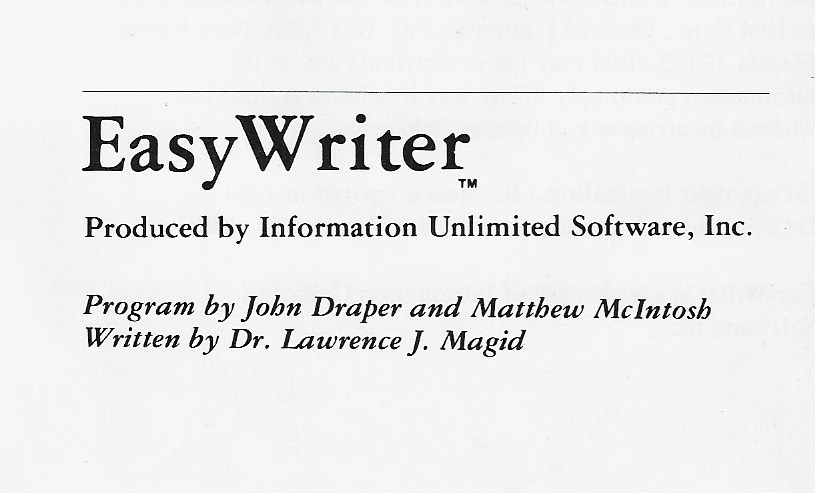
Forty years ago this month, I started my first job in the PC industry. When I signed on, I thought I’d be writing a manual for a popular Apple II word processing program. Instead, I wrote one of the manuals for IBM’s first personal computer — the IBM PC.
My soon-to-be wife and I had recently moved to California from Northampton, Massachusetts, where I had just finished my doctorate in education. I had hoped to find a teaching job at Stanford or Berkeley, but in the middle of a recession, there were no openings in my field.
Job came because of failed printing attempt
My opportunity to write the IBM manual came as a result of a failed attempt to print out my resume to use in my job search. I wrote the resume in the EasyWriter word processing program on my Apple II, but when I tried to print it on my brand-new Epson MX-80 dot matrix printer, I couldn’t get the software to work with the printer. So, I called EasyWriter’s publisher, Information Unlimited Software in Kensington, a small town near Berkeley — for tech support.
The person helping me knew all about EasyWriter but nothing about my printer so on a call that lasted nearly an hour, I read him some of the codes from the Epson manual, and the two of us eventually figured out how to get the software to work with the printer. At the end of the call, I asked him what he did besides tech support, and he told me he was the founder and president of the small company. I immediately blurted out that I needed a job. He asked me if I was a technical writer. I didn’t admit that I had never heard that term, but I did say that I just wrote a technical dissertation, so he invited me to visit him to discuss working for the company.
He hired me, and the next day I came back thinking I would go to work on a new EasyWriter manual for the Apple II. Instead, I was led to a secret laboratory down the block where my boss undid the two locks on the front door, disarmed the security system and escorted me into a crowded and untidy room. On the table was a disassembled computer that didn’t look at all familiar to me. It was a prototype of what would months later become the IBM PC — the most influential personal computer ever made.
Cap’n Crunch
It was then that I met EasyWriter’s main programmer, John Draper, also known as “Captain Crunch,” the legendary “phone phreak” who had earlier gone to prison for using a whistle from Cap’n Crunch cereal boxes to illegally make free phone calls back when long distance calls were very expensive. I found it ironic to be working with an ex-con hacker on a project for IBM, which at the time, was one of America’s stodgiest corporations.
Almost every night, after I finished working on the manual that day, my wife and I would drive from our home in Albany to San Francisco Airport to put a print-out and a floppy disk with that day’s work on the Delta Dash to IBM’s secret PC development lab in Boca Raton, Florida. The reason I had to use overnight air was because, unlike me, our contacts at IBM didn’t have a modem.

Unlike the software, the manual got a good review
The very first issue of PC Magazine panned the PC version of EasyWriter, but my manual got a good review from PC Magazine’s Andrew Fluegelman, “The first impression is likely to be that the EasyWriter program does in fact live up to its name. The documentation follows the superb format of the other PC manuals, being elegantly printed and clearly written and making good use of boldface headings and examples printed in contrasting green ink. I was able to sit down and read through the entire body of the manual (84 pages including a tutorial) in about an hour and come away feeling that I had a fairly good handle on the way the program worked,” wrote Fluegelman. Unfortunately, the review of the software itself wasn’t so glowing as the article’s title, “Not-So-Easywriter” implied. I felt like the chef on the Titanic where, I’m told, the food was rather good.
A few months after I finished the IBM manual, I decided to leave IUS to pursue a journalism career, so I walked into the office of PC Magazine to meet with publisher David Bunnell and editor Jim Edlin. They agreed to hire me to work for Edlin in the editorial department, but that weekend, Bunnell and Edlin had a disagreement which led to Edlin’s departure. Bunnell remained editor-in-chief, and with essentially no journalism experience, I was promoted to editor. In that capacity, I worked with and became good friends with Not-So-Easywriter author Fluegelman who, with Bunnell, later went on to start PCWorld and MacWorld magazines.
Bunnell and I had our own falling out a few months later, which resulted in my departure from PC. But Bunnell and Fluegelman later brought me on as a contributing editor of PCWorld magazine, and later still, I worked for Bunnell at Upside magazine. We remained friends and colleagues till he died in 2016.
The small software company I worked for in 1981 shut its doors long ago as did all but one of the handful of companies contracted to write software for IBM’s new machine. The one surviving company is Microsoft, which provided the PC-DOS operating system for IBM. Microsoft later released a version of that software called MS-DOS, which powered scores of brands of PCs for decades. Microsoft Windows is based on MS-DOS, and if you type CMD in the Windows start menu, the MS-DOS command prompt is still there.
These days, software manuals are an endangered species as is boxed software itself. Although I occasionally use Microsoft Word, I’m writing this column in WordPress, the online publishing platform used by the Mercury News and millions of bloggers. I also use Google Docs, which is a more than adequate substitute for word processing software. Both Google Docs and WordPress are free, and neither comes with a printed manual.
Forty years after starting my tech writing career, I’m still finding it interesting, because it keeps changing and becoming increasingly woven into the fabric of our entire society and culture.